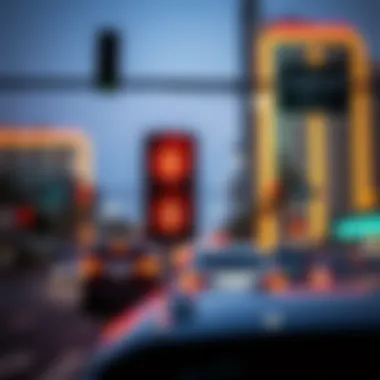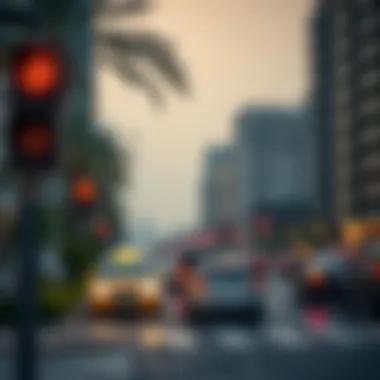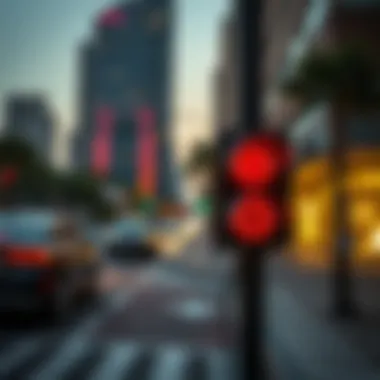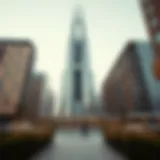Understanding Red Light Violation Fines in Dubai


Intro
Driving through Dubai can be a thrilling experience, offering stunning architecture and impressive road systems. However, with this excitement comes the responsibility of adhering to traffic laws, especially when it comes to stopping at a red light. In a city that prioritizes road safety, red light violations incur hefty fines, reflecting a zero-tolerance policy toward reckless driving. In this article, we will explore the nuances surrounding these fines, the implications for offenders, and how one can navigate the often complex web of regulations in Dubai.
Failure to comply with traffic rules can lead to serious consequences. Navigating through this landscape requires an understanding not only of the penalties but also of preventive measures you can take to ensure you remain on the right side of the law. In particular, we will look into the legal framework governing red light violations, the enforcement mechanisms in place, and some of the newer technologies being employed to monitor and deter infractions. This knowledge isn't just for the safety of individual drivers; it contributes to the well-being of everyone on the road.
Equipped with this information, the aim is for readers to have a richer understanding of the red light violation fines in Dubai while promoting safer driving habits. Whether you are a resident, a visitor, or someone who frequently drives in Dubai, being informed can save you from unnecessary financial burdens and further complications.
Understanding these key aspects can make you not only a better driver but also a good citizen in a city that values order and safety. Let's delve into the intricacies of this topic.
Overview of Traffic Regulations in Dubai
In a bustling metropolis like Dubai, where the skyline is dotted with architectural marvels and traffic flows incessantly, the need for robust traffic regulations becomes paramount. These regulations are not mere suggestions, but essential frameworks that maintain order and safety on roads, which are crucial for both residents and visitors. Understanding the full scope of traffic rules can save lives and facilitate smoother vehicular movement, an invaluable insight for first-time travelers and long-time inhabitants alike.
Importance of Traffic Laws
Traffic laws in Dubai serve multiple critical functions. Primarily, they aim to ensure safety, reducing the risk of accidents that can occur in a city teeming with vehicles. By adhering to these laws, drivers can avoid tragic incidents that often stem from reckless behaviors, such as speeding or running red lights. The regulations reflect the authorities' commitment to creating a disciplined driving culture, which is indispensable in a rapidly developing urban environment.
Moreover, the traffic laws stabilize the flow of vehicles, which is particularly vital given the heavy congestion in some areas. An informed driver, one who recognizes and obeys these rules, contributes to maintaining harmony on the roads, which benefits everyone involved. For instance, roundabouts, speed limits, and pedestrian crossings are all designed to facilitate safe passage, and ignoring them can lead to dire consequences.
Key Traffic Violations
In trying to understand traffic regulations, it’s worth knowing the common violations that can lead to penalties. Here are some of the most significant ones:
- Running a Red Light: This is a major offender and can land you hefty fines alongside potential points on your driving record.
- Speeding: Going over the limit isn’t just a suggestion to be ignored; it’s a clear violation that can endanger lives.
- Driving Under the Influence: This is treated with zero tolerance. The laws are stringent with severe penalties.
- Using a Mobile Phone While Driving: This has become increasingly relevant with the rise of technology; it distracts drivers and can lead to tragic outcomes.
- Failure to Wear Seatbelts: Not only is it a violation, but it undermines your safety significantly.
These violations are not just numbers on a chart; they represent real-life scenarios that can lead to unforeseen accidents and tragedies. Understanding these common infractions provides insight into why traffic regulations are enforced and highlights the importance of adhering to them. By recognizing these violations, drivers can better navigate the streets of Dubai and contribute to making the roads safety zones rather than accident hotspots.
Red Light Violations Defined
When we talk about traffic rules in any bustling city, red light violations sit at the very top of the chain in terms of both severity and their implications. In Dubai, where rapid urbanization and a swelling population contribute to the complexity of road safety, understanding red light violations becomes paramount not just for car drivers but all stakeholders using the streets. Making sense of this topic opens up a discussion about crucial elements that affect public safety, individual rights, and civic responsibility.
Understanding Red Light Signals
A red light is a clear signal to motorists: stop and wait. It’s as straightforward as that. But how often do people genuinely grasp the significance of that bright red hue? For many, it’s treated like a suggestion—one that can be overlooked in moments of haste. The various signals associated with traffic lights, such as yellow (caution) and green (go), create a language of their own for drivers. The understanding of these signals not only contributes to effective road management but also fosters a culture of safety among drivers, pedestrians, and cyclists.
Consider how traffic lights work in unison with road signs and pedestrian crossings. They aren’t mere decorations; they enforce order amid the turmoil of city life. A lack of understanding related to these signals can lead to disastrous outcomes. When someone rolls through a red light, they might mistakenly believe they are expediting their journey. However, the repercussions can be severe—potential accidents spark danger for everyone on the road.
Consequences of Ignoring Signals
Ignoring a red light can open a Pandora's box of legal troubles and liabilities. The immediate consequence is a hefty fine, which can vary based on the severity and context of the violation. In Dubai, the fine for running a red light can escalate quickly, ranging from AED 1,000 to AED 3,000 and adding points to your driving record, which could lead to possible license suspension.
- Increased Insurance Premiums: It doesn’t stop at fines. Repeat violations can send your insurance premiums into orbit. Companies view offenders as high-risk and adjust their rates accordingly.
- Legal Repercussions: If an accident occurs while running a red light, that can lead to civil liability and criminal charges, depending on the circumstances.
- Potential Jail Time: In some extreme cases, ignoring a red light could result in jail time, especially if the offense is linked with injury or wrongful death.
"The consequences of red light violations aren't just monetary—there's a profound impact on one’s freedom and future."
The ripple effect of ignoring traffic signals not only threatens personal safety but disrupts the very fabric of orderly traffic flow. It can provoke road rage and escalate tensions among drivers, turning everyday commutes into battlegrounds. Ultimately, understanding the importance of obeying red light signals and recognizing the ramifications of violations fosters a responsible driving culture. This culture not only reflects individual actions but also influences the broader community, paving the way for safer travels in Dubai.
The Fine Structure for Violations
Understanding the fine structure of traffic violations in Dubai, especially red light offenses, is more than just memorizing numbers; it plays a crucial role in maintaining order and encouraging compliance on the roads. This structure not only outlines the specific penalties associated with these violations but also reflects the seriousness with which the Emirate views road safety.
When a motorist disregards a red light, the repercussions extend beyond a mere fine. The imposed penalties serve as a deterrent for drivers and aim to cultivate a culture of responsible driving. Furthermore, these fines contribute to the overall maintenance and development of infrastructure, which in turn enhances road safety. In a city as dynamic as Dubai, where traffic is a sprawling issue, understanding these fines and why they exist can lead to better decision-making on the road.


Types of Fines Imposed
The classification of fines for red light violations is quite specific in Dubai. When a driver runs a red light, the resulting fine can vary depending on the severity of the infraction and circumstances surrounding the incident. Here are some notable points regarding fine types:
- Standard Fines: Typically, running a red light incurs a fine of about 1,000 AED. This amount is uniformly enforced across the city, reflecting the standard policy on such violations.
- Additional Penalties: Beyond the standard fine, offenders may also face other consequences such as points on their driving record. Accumulating too many points can lead to suspension of driving privileges, which adds additional weight to the traffic system.
- Aggravating Factors: In situations where an accident occurs due to running a red light, fines can substantially increase. This can reach up to 2,000 AED or more, considering damages and potential injuries involved.
"Fines serve not just as a punishment, but a reminder of the collective responsibility we share on the roads."
These fines are meant to be more than just a financial penalty; they emphasize that road safety is a community concern, highlighting the imperative for all drivers to adhere to traffic rules.
Payment Processes and Options
Navigating the payment process of traffic fines in Dubai is designed to be straightforward and accessible. Motorists who receive fines for red light violations have several payment options available:
- Online Payments: The Dubai Police offer a convenient online platform where residents can view and pay their fines. This service can be accessed through the official Dubai Police website or their mobile application, making it easy to settle fines without lengthy queues or waiting periods.
- Mobile Applications: Various apps allow for immediate payment. The Dubai Police app is popular and includes features like viewing violations, paying fines, and even reporting minor accidents.
- In-Person Payments: For those who prefer traditional methods, fines can also be settled at designated service centers throughout Dubai. It is advisable to have identification and the violation details ready when making a payment.
- Payment Plans: In certain scenarios, options for installment payments may be available, particularly for drivers facing financial difficulty. It is recommended to inquire directly with the traffic authorities for specifics on eligibility.
Overall, understanding the fine structure and payment processes helps to demystify what can often be a daunting experience for many drivers. Knowledge is power, and ensuring compliance with traffic regulations not only keeps individuals safe but fosters a more secure environment for all road users.
Legal Framework Governing Traffic Violations
The legal framework surrounding traffic violations in Dubai plays a pivotal role in maintaining order and safety on the roads. Understanding this framework is essential for motorists as it not only lays down the rules they must follow but also clarifies the repercussions of any infractions, including red light violations. A well-structured legal framework contributes to societal order and ensures that all road users adhere to the same standards, ultimately fostering a culture of responsible driving.
Relevant Laws and Regulations
In Dubai, traffic regulations are codified under various laws and decrees aimed at promoting road safety and reducing accidents. Federal Law No. 21 of 1995 concerning Traffic is a cornerstone document, which outlines a variety of traffic offenses and their corresponding penalties. This law is regularly updated to adapt to the evolving landscape of urban mobility, ensuring that it remains relevant.
Key aspects of the law include:
- Specific penalties for different types of violations, including harsh fines and demerit points for red light infractions.
- Designation of authority to the Dubai Police and other enforcement agencies, specifying their roles in implementing these laws.
- Provisions that address the use of technology, such as speed cameras and automated traffic signals, to monitor and enforce compliance.
Additionally, the RTA (Roads and Transport Authority) sets forth regulations governing traffic control measures, which include guidelines for traffic signal installation and maintenance. Understanding these laws and their implications is crucial for every driver in Dubai, as violating them can lead to severe financial and legal consequences.
Defenses and Appeals Process
For individuals who receive a fine for a red light violation, there exists a legal recourse in the form of appeals. Knowing how to navigate this process can significantly alleviate the burden of an unintentional infraction.
The appeals process involves:
- Filing a formal objection: Motorists can file a complaint with the relevant traffic authority, typically within a defined period following the issuance of the fine.
- Submitting evidence: It is vital to provide any supporting documents or proof that could help substantiate the defense. This might include photographs, eyewitness accounts, or any footage from traffic cameras that could be reviewed by the authorities.
- Awaiting a decision: After the appeal is lodged, the authorities will review all submitted evidence and make a determination.
The system does allow for the possibility of the fine being reduced or even canceled if sufficient grounds are established. However, it is imperative to approach this process with a clear understanding of the laws and the procedures involved. Knowing when and how to appeal not only protects the rights of the driver but also contributes to a more equitable traffic enforcement system.
To sum it up, the legal framework governing traffic violations in Dubai is designed to ensure safety while providing a clear guideline for enforcement and recourse. For more detailed information about Dubai's traffic regulations, you can refer to the Dubai Police website or the RTA website for further clarity on applicable laws and procedures.
Enforcement Mechanisms
Enforcement mechanisms are critical in maintaining the integrity of traffic regulations in Dubai, particularly in the context of red light violations. Understanding these mechanisms sheds light on how the law is upheld, promoting safer driving practices. The mechanisms ensure that violations are detected promptly and offenders are held accountable. This section delves into two pivotal components: the role of traffic cameras and the responsibilities of traffic police.
Role of Traffic Cameras
Traffic cameras have become a staple in modern urban planning, particularly in a city like Dubai, where rapid growth brings unique challenges to traffic management. These devices serve as the eyes on the roads, effectively monitoring and recording violations around the clock. They operate on various technologies, including sensors embedded in the road or advanced video analytics that automatically identify when a vehicle enters an intersection against a red light.
Some benefits of traffic cameras include:
- Real-time Monitoring: Unlike a human officer, cameras function without fatigue and can continuously monitor numerous lanes simultaneously.
- Objective Evidence: Captured footage serves as impartial evidence in an incident, reducing disputes and protecting both the officer's and motorists' rights.
- Deterrence Factor: The presence of cameras has been shown to discourage reckless behavior. Many drivers become more cautious, resulting in safer roadways.


However, there are considerations around privacy and the potential for misuse. Ensuring these cameras are deployed transparently and consistently is essential to maintain public trust in the system. Local authorities must balance efficiency with residents' rights while enhancing safety on the roads.
Traffic Police Responsibilities
Traffic police play an indispensable role in the enforcement of traffic laws, complementing technology with a necessary human touch. Their responsibilities extend beyond merely catching offenders; they are also educators, advisors, and first responders.
Key responsibilities include:
- Patrolling: Officers patrol areas where violations are prevalent, ready to respond to incidents and manage traffic flow in real-time.
- Issuing Citations: When a violation is observed, traffic police can issue a ticket directly. This face-to-face interaction also opens the floor for dialogue and education about road safety.
- Investigating Incidents: In cases of accidents, officers investigate, gather evidence, and provide a clear picture of events, which aids legal processes.
- Community Engagement: Many police forces engage in outreach activities, speaking at schools, or conducting workshops to highlight the importance of obeying traffic rules.
This synergy between traffic cameras and police ensures a comprehensive approach to law enforcement on roads. It allows for immediate action against violators while fostering an environment where road safety is prioritized.
"A safer driving culture is a shared responsibility, where technology and human effort work hand-in-hand to create a safer Dubai for all."
By understanding these mechanisms, motorists and stakeholders gain greater insight into how traffic regulations are enforced, ultimately supporting efforts to cultivate safer road environments.
Impact on Road Safety
The significance of examining the impact of traffic violations, particularly red light violations, on road safety cannot be overstated. In Dubai, where the number of vehicles is rapidly increasing, understanding how these infractions influence not only individual behavior but also collective road safety is pivotal. Red light violations often result in severe consequences, including accidents that can lead to injuries or fatalities. By comprehensively analyzing this issue, stakeholders can implement measures to foster a safer driving environment.
Statistical Analysis of Violations
Analyzing data related to traffic violations gives us a clearer picture of the extent of the problem. In Dubai, reports indicate that red light violations are consistently among the top contributors to traffic accidents. According to government statistics, around 28% of all traffic accidents are linked to ignoring traffic signals. This stark figure places a spotlight on the urgent need for stricter enforcement and more effective education about the dangers of such behavior.
Several studies have indicated that the regions with the highest incidences of red light violations often correlate with accident hotspots. For instance:
- Time Factors: Most violations tend to occur during peak traffic hours, suggesting a correlation between congestion and risky driving behavior.
- Location Specifics: Certain intersections show higher rates of violations, which may warrant additional monitoring or even redesign to mitigate risk.
- Demographic Insights: Younger drivers, particularly those under 25 years old, tend to be involved in such infractions more often than their older counterparts.
The data does more than just highlight the issue; it drives home the point that education and reform must adapt based on these trends. With a clearer understanding of when and where violations happen, authorities can tailor their resources effectively to improve road safety.
Long-Term Effects on Traffic Behavior
Long-term implications of red light violations stretch beneath the surface. Beyond immediate accidents, these incidents can shape future driving behavior and public perception towards traffic laws. A few notable effects include:
- Desensitization to Rules: Regular violations can lead drivers to become lax about following traffic signals, creating a cultural norm of rule-bending.
- Increased Penalty Awareness: As fines and penalties become more common, they can sometimes serve as a double-edged sword. While they deter some drivers, they can also breed resentment if perceived as excessive, leading to a reluctance to respect laws.
- Education and Compliance: Persistently high violation rates may fuel public campaigns and educational initiatives, ultimately fostering a more law-abiding culture over time.
Understanding the intricacies of these long-term behaviors is essential for policymakers. Adapting strategies, whether through awareness programs or technological solutions, can significantly contribute towards molding responsible drivers.
"The value of road safety extends beyond policies; it shapes community trust and individual responsibility across the board."
Addressing red light violations is not merely a matter of penalizing offenders. It's about creating a societal environment where safe driving becomes a shared priority. Through detailed analysis and adaptive strategies, Dubai can pave the way for a safer future on its vibrant roads.
Preventive Measures for Motorists
When discussing traffic laws within Dubai, the conversation often pivots towards punitive measures and fines. However, an equally important aspect is the preventive measures that can significantly reduce the incidence of traffic violations, particularly red light violations. By understanding and adopting safe driving practices, motorists can not only avoid costly penalties but also contribute to a safer driving environment for everyone.
Safe Driving Practices
Safe driving practices form the backbone of any effective preventive strategy. Here are some crucial points to consider:
- Maintain a Safe Following Distance: Keeping a significant gap between your vehicle and the one ahead allows for better reaction time. If the car in front stops suddenly at a red light, you’ll have ample time to react and avoid slamming on your brakes.
- Adhere to Speed Limits: Excessive speed can lead to careless decisions. When approaching intersections, driving within speed limits provides you with the opportunity to stop smoothly and safely when the light turns yellow.
- Be Attentive and Avoid Distractions: This includes not only focusing on the road but also limiting distractions like phone use. Staying alert helps drive home the message that awareness can prevent misjudgments regarding traffic signals.
These practices not only prevent violations but also enhance overall road safety, leading to a healthier driving culture across Dubai.
Education and Awareness Campaigns


Education and awareness play a pivotal role in changing the behavior of motorists. Here’s how they contribute effectively:
- Targeted Community Outreach: Local authorities and organizations frequently hold workshops and seminars aimed at educating drivers about the consequences of red light violations. This face-to-face interaction can be much more effective than printed pamphlets.
- Use of Social Media: Platforms like Facebook and Instagram have become essential tools for spreading awareness. Short videos, infographics, and testimonials can effectively communicate the dangers associated with ignoring red lights, reaching a diverse audience.
- Partnerships with Driving Schools: Incorporating information about red light penalties into driving school curriculums ensures that new drivers understand the importance of obeying traffic signals right from the beginning of their driving journey.
- Incentive Programs: Some initiatives provide rewards or discounts for safe driving practices observed over a time frame, improving motivation and commitment to road safety.
A well-informed public is more likely to comply with traffic regulations, creating a ripple effect that can lead to fewer violations and accidents.
"Education is the most powerful weapon which you can use to change the world." - Nelson Mandela
Adopting preventive measures is not just about complying with laws but about fostering a culture of responsibility and care on the roads. For residents and visitors alike, understanding and embracing these practices can be transformational, paving the way to a safer Dubai.
Technological Innovations in Traffic Monitoring
The landscape of traffic monitoring in Dubai is rapidly evolving. This transformation is largely driven by technological innovations that enhance the effectiveness of enforcement mechanisms surrounding red light violations. The increasing use of advanced technologies contributes significantly not only to compliance with traffic laws but also to the overall safety of the city's roads. Through these innovations, Dubai has taken significant strides in becoming a smart city, focusing on the well-being of its citizens and visitors alike.
Advancements in Traffic Camera Technology
Recent advancements in traffic camera technology have revolutionized the way traffic violations are recorded and processed. High-definition cameras equipped with night vision capabilities have been deployed across various intersections, allowing for better visibility during low-light conditions. Additionally, many of these cameras employ real-time processing algorithms that enable them to capture images of vehicles disregarding red signals instantly.
These cameras not only ensure the precision of the documentation but also facilitate instantaneous communication with the central traffic control system. Some notable features include:
- 360-degree coverage: Ensures no blind spots at intersections.
- License plate recognition: Captures vehicle registration details for swift identification of offenders.
- Instant alerts: Sends real-time notifications to traffic authorities when violations occur.
The implementation of such technology serves to deter potential offenders, as the knowledge of being monitored is often enough to encourage cautious driving behavior.
Use of AI and Data Analytics
The integration of Artificial Intelligence (AI) and data analytics into traffic monitoring is a game-changer in the field. These technologies are now being employed not only in analyzing traffic patterns but also in predicting violations before they happen. By collecting and analyzing vast amounts of data from traffic cameras and sensors, AI can help local authorities anticipate where violations are likely to occur.
Some benefits of using AI and data analytics in traffic monitoring include:
- Predictive modeling: By analyzing historical data, AI can forecast potential high-risk areas and times, allowing for preemptive measures.
- Enhanced pattern recognition: Detects unusual behavior such as aggressive driving or frequent signal violations, enabling targeted enforcement actions.
- Resource optimization: Helps in deploying police resources more effectively based on current traffic conditions and violation hotspots.
These advancements suggest a shift from reactive to proactive traffic management, emphasizing preventative strategies over punitive actions. According to a recent study, cities employing AI-driven analytics have seen noticeable reductions in traffic violations and accidents, further underscoring the relevance of these technologies in Dubai's pursuit of safe roadways.
Incorporating technological innovations not only streamlines the enforcement of traffic laws but also enhances public safety and compliance through proactive measures.
Staying abreast of these developments is crucial for all stakeholders involved, including investors, homeowners, and real estate professionals, as they contribute to shaping a bustling urban environment that is both safe and efficient.
Public Perception of Traffic Penalties
Navigating the complex web of traffic laws in Dubai isn’t just about understanding the rules; it’s also about grasping how the public views the penalties tied to infractions like red light violations. The perception of traffic penalties plays a crucial role in influencing driver behavior and the overall effectiveness of traffic laws. Community attitudes can either bolster compliance with regulations or foster resentment toward law enforcement practices.
Community Attitudes Towards Enforcement
The public's attitude toward traffic enforcement hinges on several factors, including the perceived fairness of penalties and the effectiveness of enforcement measures. Many residents believe that strict enforcement helps to maintain road safety. When penalties for infractions like running a red light are visible and understood, it can deter reckless driving. However, if people perceive these penalties as excessive or disproportionately punitive, support may falter.
Some might argue that the fines are a necessary evil to encourage safe driving, while others feel they are merely a means for the government to swell its coffers. For instance, new drivers often express frustration at learning about hefty fines for seemingly minor mistakes, fueling negative sentiments towards authorities. Local community discussions often reflect this ambivalence; many recognize the necessity of traffic laws yet question their implementation.
In some neighborhoods, informal support groups may emerge where drivers share experiences about disputes over tickets. This can create a shared culture of mistrust towards the enforcement mechanisms. Hence, keeping lines of communication open and fostering transparency becomes paramount in altering public perception.
Impact on Driving Culture
The way the public perceives traffic penalties significantly shapes the driving culture within a community. When penalties are understood as a tool for promoting safety rather than a punitive measure, it encourages a culture of responsibility among motorists. For example, some drivers might invest time in attending defensive driving courses or even engage in community-led road safety programs if they perceive a genuine concern for public safety behind the fines.
Conversely, a culture perceived as punitive may spawn defiance rather than compliance. In such environments, individuals might become less inclined to heed traffic signals. Instead of slowing down for a yellow light, they might speed up, believing that the risks outweigh the penalties.
“Perceptions shape reality. What drivers believe about penalties can often dictate their behaviors on the road.”
In Dubai, with its combination of international residents and local nationals, driving habits can vary widely. Some ex-pats hail from places where traffic laws may be less strictly enforced, creating friction when they encounter Dubai’s stringent system. Educating diverse communities about why these penalties exist—and highlighting their role in saving lives—can drive cultural shifts towards safer driving practices.
In summary, public perception of traffic penalties in Dubai acts as both a mirror and a compass for road safety culture. Recognizing attitudes towards enforcement and its wider influences can guide policymakers in making informed decisions that aim not just to penalize but also to educate and cultivate a responsible driving community.















